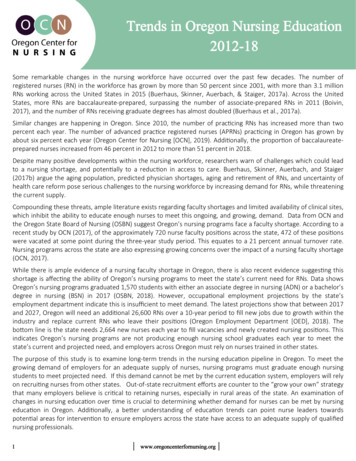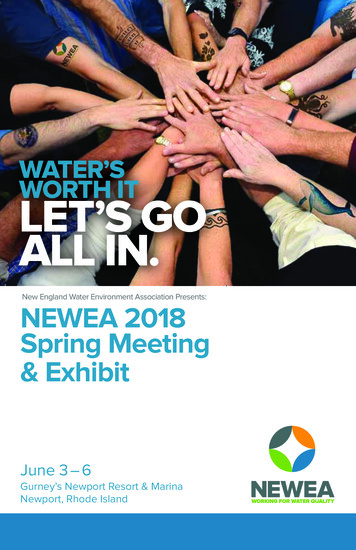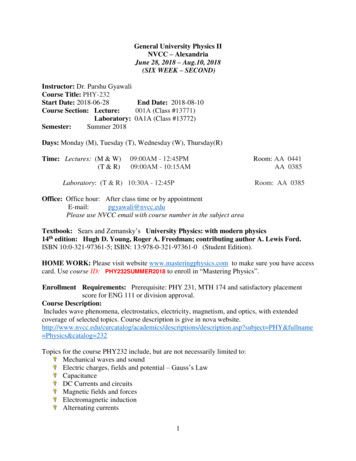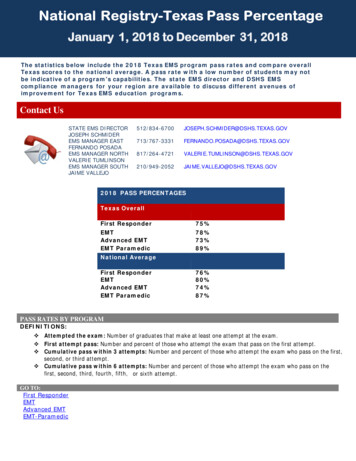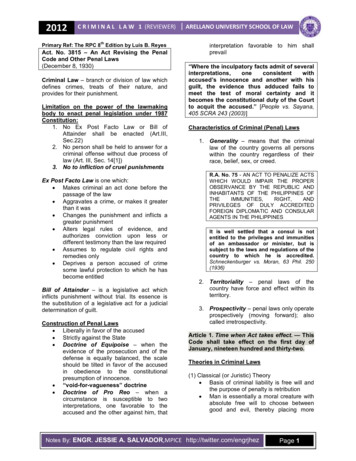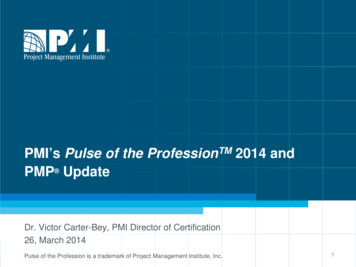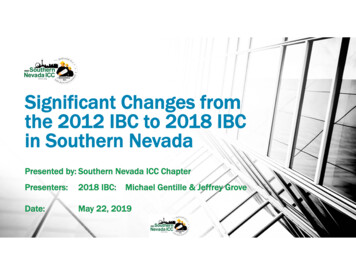
Transcription
Significant Changes fromthe 2012 IBC to 2018 IBCin Southern Nevada
Learning Objectives A brief overview of significant base code changes between the 2012 IBC and the 2018 IBC. A comprehensive review of adopted Southern Nevada amendments under the 2018 IBC. A review of the unique high-rise/ mid-rise building design requirements in each localSouthern Nevada Authority Having Jurisdiction (AHJ). A primer on the 2018 International Existing Building Code (IEBC) in Southern Nevada. A review of the “rules of the road” when applying the 2018 IEBC.5/22/20192
Course Schedule7:30am – 8:00amRegistration8:00am – 8:10amPresenter Intros & Course Schedule8:05am – 10:15am2018 IBC General CommitteeMichaelGentilleCBO(Mike Gentille & Jeffrey Grove)10:15am – 10:30amBREAK10:30am – Noon2018 IEBC n Woodward & Edward .E.
Speaker Biographies - 2018 IBC GroupMichael Gentille, C.B.O. PCNA Group Consulting Engineers, Inc. – Founder & President 2018 SNICC - IBC General Committee Chairman Southern Nevada ICC Chapter – Industry Board Member ICC Certified Building OfficialJeffrey Grove, P.E. Jensen Hughes – Senior Fire Protection Engineer / Technical Fellow Named Jensen Hughes’ Liaison to National ICC in early 2019 2015/2018/2021 National ICC Means of Egress Committee Member Registered Fire Protection Engineer (Multiple States)5/22/20194
Recent 2018 IBC / IEBC Code Adoptions In 2012, all local AHJ’s adopt sameIBC amendment package In 2018, high-rise building definitionsdiverge among the local AHJ’s In 2012, only City of Las Vegasadopted the IEBC codeIn 2018, all local AHJ’s adopt the IEBCCode CycleIBCIEBC2012All Local AHJ’sAdopt the SameAmendmentsOnly Adopted byCity of Las Vegas2018All Local AHJ’sAdopt the SameAmendments witha Few SignificantExceptionsAll Local AHJ’sAdopt the SameAmendments5/22/20195
Chapter 2Sleeping Unit ClarificationsSleeping Unit: A single unit that provides rooms or spaces for one or more persons,includes permanent provisions for sleeping and can include provisions for living, eating andeither sanitation or kitchen facilities but not both.KEY CONCEPTS: The provisions in Chapter 7 that require sleeping units to be separated fromadjacent groups and the corridor, but does not require the bedrooms within agiven sleeping unit to be separated from the associated living room orbathrooms within that same unit. Clarification also provided that only the main corridors have fire alarms, andsmoke alarms can be within the unit. Previously, it was unclear if the living andsanitation were considered part of the unit or an extension of the main corridor.5/22/20196
Chapter 3Occupancy ClassificationsGroup B: Food processing establishment and commercialkitchens NOT associated with restaurants, cafeterias andsimilar dining facilities LESS than 2,500 SF in area.Group F: Food processing establishment and commercialkitchens NOT associated with restaurants, cafeterias andsimilar dining facilities GREATER than 2,500 SF in area.Group A-2: Commercial kitchens THAT ARE associatedwith restaurants, cafeterias and similar dining facilities,regardless of area.5/22/20197
Chapter 3 - Section 311.1.1Accessory Storage SpacesA room or space for storage purposes (regardless of roomsize) that is accessory to another occupancy shall beclassified as part of that occupancy. The occupant load factor of 1:300 for storage may still be applied References to allowable area and percent of area are no longer applicable5/22/20198
Chapter 4 - Section 403High-Rise BuildingsUnder 2012 IBC, all local AHJ’s defined a “high-rise building”as a building having an occupied floor more than 55 feetabove the lowest level of fire department vehicle access.However, under 2018 IBC adoption, the rules vary among each local AHJ as follows: City of Henderson adopted the base code provision of 75 feet (without exception) City of Las Vegas also adopted the 75 feet provision, but also adopted “IBC Section 429”which applies “mid-rise building” rules between 55 feet to 75 feet Clark County, City of North Las Vegas, State of Nevada and Clark County School District allmaintain the 55 feet carry-over provisions from 2012 IBC (without exception)5/22/20199
Chapter 4 - Section 404AtriumsAn EXCEPTION is added to this section (in thebase code) to omit the fire barrier requirement: EXCEPTION: KEY EXAMPLE: Smoke control systems arenot required for 2-story atriums, in other thanGroup I-2 and I-1 (condition 2) occupancies. NOTE: Per IBC 404.9.3, where egress is not atlevel of exit discharge, travel distance throughatrium shall not exceed 200 feet.A fire barrier is not required between theatrium and the adjoining spaces where the atrium is notrequired to be provided with a smoke control system.NOTE: Per IBC 404.9, up to 50% of interior exitstairways are permitted to egress through anatrium at the level of exit discharge.5/22/201910
Chapter 4 – Newly Added Sections Section 426 – Combustible Dusts, Grain Processing/Storage Section 427 – Medical Gas Systems Section 428 – Higher Education Laboratories5/22/201911
Chapter 5 - Section 503.1.4Occupied RoofsA roof level or portion thereof is permitted to be used as anoccupied roof provided the occupancy of the roof is anoccupancy that is permitted by Table 504.4 for the storyimmediately below the roof. Exception: The roof occupancy shall not be limited to theoccupancies allowed on the story below when the building isfully sprinklered and fire alarm occupant notification isprovided on the occupied roof Note: Occupied roof is NOT a story. As such, it’s area is notincluded in the overall building area calculation Note: There are also additional restrictions on enclosures5/22/201912
Chapter 5 - Section 504.4Number of StoriesAn EXCEPTION is added to this section (via local amendment) toallow one (1) additional story for certain buildings: EXCEPTION: KEY EXAMPLE: Under this section, a 4-story Group R-2 buildingof Type V-A construction may be increased to 5-stories if thefeatures noted above are provided.In occupancies other than Groups E, F, H and I, where a building ofType II, III-A, or VA construction is equipped throughout with an approved automaticsprinkler system and complies with the high-rise provisions of Section 403, themaximum number of stories may be increased by one (1).5/22/201913
Chapter 5 - Section 505.2.3MezzaninesDirect access to at least one exit at mezzanine level is no longer required for enclosed mezzanines.This change is considered to be an acceptable reduction in required means of egress.5/22/201914
Chapter 5 - Section 510.2Horizontal Building Separation AllowanceThis provision essentially allows a building of a givenconstruction type to be constructed above a Type I-A building,while considering each to be two (2) separate and distinctbuildings where a 3-hour horizontal assembly divides them. 2012 IBC: Type I-A building is limited to 1-story above grade 2018 IBC: Number of stories in Type I-A building not limited KEY PREMISE: This change was allowed since the maximumoverall building height (in feet) is the determining factor here,not the actual number of stories within the building.5/22/201915
Chapter 5 – 2012 Table 5035/22/201916
Chapter 5 – 2018 Table 504.35/22/201917
Chapter 5 – 2018 Table 504.45/22/201918
Chapter 5 – 2018 Table 506.25/22/201919
Chapter 6 – Table 601Footnote b.Except in Group F-1, H, M and S-1 occupancies,all portions of the roof construction,including primary structural frame membersare now exempt from fire-resistiverequirements where every portion of the roofconstruction is at least 20 feet above any floorimmediately below.5/22/201920
Chapter 7 – Section 705.3Buildings on the same lotAn EXCEPTION is added to this section (via localamendment) to allow multiple lots in a commercialsubdivision to be considered a single lot if certain conditionsare met: EXCEPTION: KEY CONCEPT: This provision was added to addressvacated big-box stores in strip malls to allow them toshare utilities and limit demising wall separationrequirements.At the discretion of the Building Official, multiple lotswithin a commercial subdivision established in accordance with NRS, maybe considered a single lot where approved reciprocal agreements are inplace to maintain the building and associated building service equipment.5/22/201921
Chapter 7 – Section 706.2Fire Wall Structural StabilityModifications were made to this section to clarify structural integrity requirements for a Fire Wall. REQUIREMENT: Designed and constructed to allow collapse of the structure on either sidewithout collapse of the fire wall under fire conditions. KEY CONCEPT: Building Height & Area Calculations Only. NOTE: Double Fire Walls inaccordance with NFPA 221are still permitted.5/22/201922
Chapter 7 – Section 717.1.1Ducts and air transfer openingsDucts transitioning horizontally between shafts shallnot require a shaft enclosureHowever, where ducts penetrate each shaft, adamper must be provided5/22/201923
Chapter 9 – Section 902.2Fire Riser RoomsA new section is added (via local amendment) to require adedicated sprinkler riser room for each sprinkler system.However, several exceptions to this requirement may be applied.EXCEPTIONS: Wall-mounted PIV and exterior access provided to a monitoring panel in aconditioned room (where approved by the Fire Official) Where a single system serves the building and is controlled by a PIV In multi-story buildings, floor control risers are permitted on each floorlevel in an exit stair enclosureKEY REQUIREMENTS: Riser room must be 16 SF minimum, with a minimum dimension of 4feet for the 1st riser and 9 SF for each additional riser in the room Must be accessible from the building exterior and maintained between40 F and 100 F5/22/201924
Chapter 10Means of EgressSignificant changes and reorganization to the entire chapter have occurred. Several previouslyseparate requirements now moved into a single code section (Section 1006).KEY CHANGES: Table 1004.5 – Occupant load factor for Business went from 100 gross to 150 gross. Table 1004.8 – Concentrated Business Use Areas added to address call centers, trading floors, etc. These may becalculated at actual occupant load (if approved by Building Official), but not less than 1:50 OLF. Section 1006.3 – Clarification that when stairways serve more than one story or occupied roof, only the occupant loadon that story or occupied roof are used to calculate the required number and minimum size of exits. Local amendment to Table 1006.2.1 allows Group R-1 spaces with one exit a maximum of 20 occupants (base code 10 occs.) and maximum common path of travel 125 feet (base code 75 feet) in sprinklered buildings. Section 1006.2.1 – The limiting factor of stories with one exit or exit access doorway changed from “travel distance” to“common path of egress travel”. Example: occupants of a 2nd story space can use unenclosed stairs as the only meansof egress, provided that the common path of travel complies with Section5/22/20191006.2.1.25
Chapter 10Means of EgressKEY CHANGES (continued):Path of egress travel to an exit shall not pass throughmore than one (1) adjacent story.EXCEPTIONS: Residential occupanciesOpen parking garagesOpen-air assembly seating and exit access stairways servingbalconies / galleries / press boxes (theaters, auditoriums,sports venues)5/22/201926
Chapter 10Means of EgressKEY CHANGES (continued):Section 1007.1 better clarifies how to measure distance between; exit access doorways, stairs & ramps.KEY REQUIREMENTS: Separation distance to be measured to any point along the width of the doorway Separation distances to be maintained for entire length of travel on stair or ramp to prevent convergence5/22/201927
Chapter 10 – Section 1004.1.2Merchantile Occupant Load FactorsThis section has been revised to be 1:60 OLF regardlessof the story on which the merchantile occupancy occurs.KEY CHANGES: In 2012 IBC, there were two different OLFs for merchantileoccupancies This change reflects the trend from multi-story single operatorbuildings to larger floor areas within a single story5/22/201928
Chapter 10 – Section 1009.8Two-Way Communication SystemsThis section has been revised to provide EXCEPTIONS to two-waycommunication system requirements at elevator landings.EXCEPTIONS: Where two way communication systems are provided in area of refuge Floors where ramps are provided Service elevators that are not designated as AME’s or accessible routes Freight elevators Private residence elevators5/22/201929
Chapter 10 – Section 1010.8Door ArrangementThis section is modified (via local amendment) toclarify the minimum dimensions for vestibules servingsmokeproof enclosures at pressurized stairways.KEY REQUIREMENTS:Vestibules shall not have a width of less than 44 inches and shall nothave a length of less than 72 inches in the direction of egress travel5/22/201930
Chapter 10 – Section 1013.2Floor Level Exit Signs in Group R-1 OccupanciesThis section is modified to provide a greater range offloor level exit signage placements.KEY REQUIREMENTS: 2012 IBC limited this range from 10 - 12 inches A.F.F. 2018 IBC increases this range from 10 - 18 inches A.F.F.5/22/201931
Chapter 10 – Section 1016.2Egress through Intervening SpacesThis section is modified to allow egress through anelevator lobby.KEY REQUIREMENTS: Access to at least one (1) exit must be provided without travelthrough the lobby Protection required for the lobby is not required to extend to exitunless required by other sections of the code (e.g. fire serviceaccess elevator lobby) Similar continuity rules as applicable to foyers and lobbies5/22/201932
Chapter 10 – Section 1023.3.1Egress through Intervening SpacesKEY REQUIREMENT: An interior exit stairway is now permitted to continue directly into an exit passageway without a required fire-door
Learning Objectives A brief overview of significant base code changes between the 2012 IBC and the 2018 IBC. A comprehensive review of adopted Southern Nevada amendments under the 2018 IBC. A review of the unique high-rise/ mid-rise building design requirements in each local Southern Nevada Authority Having Jurisdiction (AHJ). A primer on the 2018 International Existing .


